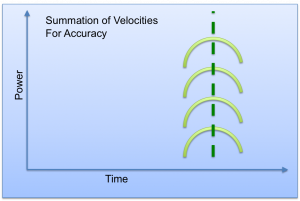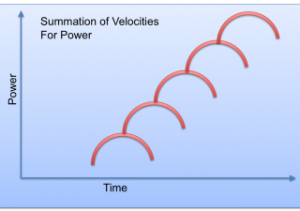Power comes from the progressive application of forces. Throwing a dart requires very little power, and thus involves few segments (just the wrist and fingers). Throwing a baseball however requires high power and more segments (hips, back, shoulder, elbow, wrist, fingers).
The most powerful movements originate from the midline of the body, and travel towards the extremities, transferring and adding power as they go.
To create accuracy, all segments must move simultaneously, as shown in the graph below. When throwing a dart, or any other object at a small target, maximise accuracy by minimising the number of joints and movements involved. Use only as many segments as are required to allow the object to reach the target.

Power however, requires a snowball effect. As one movement rolls into another, it not only transfers the force, but adds to it. If the next movement in the chain happens to soon (before the previous one has peaked) there is not enough time for force to be generated. If it happens to late, the force will already have dissipated. The ideal situation for power is shown below.

This shows the importance of correct technique for complex movements – particularly the Olympic Lifts, Clean and Jerk and Snatch. It’s worth spending the time on technique to plug any power leaks in your movement.





